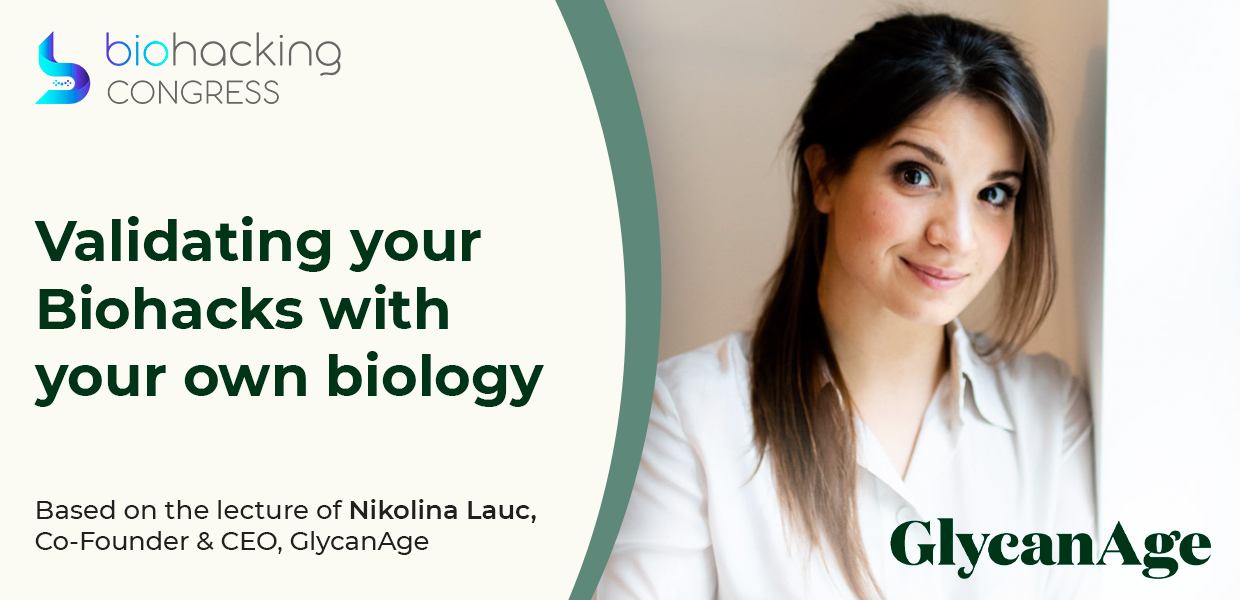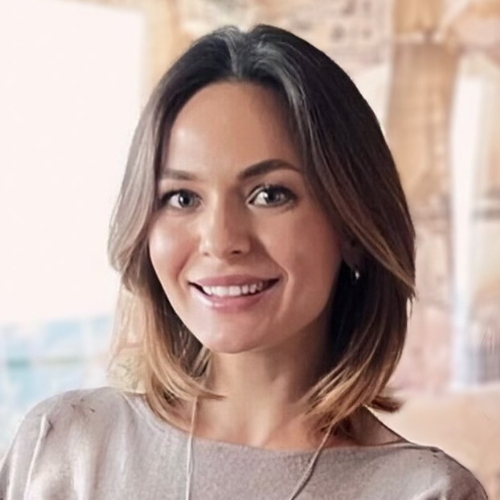Validating Biohacks with Biology
As biohackers, our goal is to hack our own biology and environment to live longer and healthier lives. Nikolina Lauc is a Co-Founder and CEO of a research-backed consumer health company called GlycanAge that measures your biological age by looking at IGG glycosylation and shows how you can do this by looking at glycans.
The problem today is that everybody is still relying on genes. To understand things like complex diseases and longevity, even to personalized diets but import, unfortunately, in practice and research, that does not work. Some genes do not define everything, they account for only about 30% of complex diseases and 20% of longevity is genetic.

Because the technology is readily available and the prices are moderate, the focus shifts from genomics to epigenomics. However, the more we move up into proteomics, lipidomics, and glycomics, the more we increase this level of useful information, complexity, and actionability.
The ultimate layer of molecular complexity is glycans in comparison to DNA, we have four building blocks, in proteins, we have twenty building blocks, and glycoproteins have two thousand building blocks. They significantly increase the complexity of our organism and give us a holistic view of what's going on. Glycans are the holistic marker of health. Our Glycan-based biomarkers integrate genetic, epigenetic, and environmental factors enabling precision medicine.
The Genome is only one of the elements that control life; multiple additional layers of complexity exist. One of the essential elements of the complexity of life is protein glycosylation.

Glycans are sugars; sugar molecules coated around your immune cells regulate their functionality, so sugars are a structural component of biology. They account for a large part of functionality. Several academic papers are explaining that glycans are involved in the development of every primary disease. They’re not just a risk factor but also a functional factor in developmental illness. They're key to realizing the goals of personalized medicine.
“One of the first things we learned in research is that the glycogens in your glycogen change with age, and this is reflective of low-grade systemic inflammation. Glycans can be both good and bad. “We're looking at the pro-inflammatory glycogens, and we see them go up with aging. The anti-inflammatory glycogens are the ones that suppress inflammation, and we see them decrease with aging. These are four European biobanks, some of them we followed for over 20 years.” Nikolina said.
Men and women are radically different in their IgG glycome. Men have a very linear path of up and down with aging. Meanwhile, women have a bump. This bump is painful menopause, so in a way, women are protected against inflammation before perimenopause, and then they have a sharp increase, and they move even a little bit quicker than men. This explains that women have an early advantage in a way they're protected, but they have a sharp increase in the second half of their lifespan. They also have more diseases.

“We have tried to explain that aging is natural, but it's also equal to decline in function. If we treat this decline before it turns into a particular disease, we're tackling the root cause or being identical to the cure. We also know that glycogen gives us a significantly prognostic view.
“In all of the research, not just done by our lab but many labs around the world, where you had a person before and after the development of a disease, we can see that likens are altered several years before. This was first discovered for arthritis which was understood more than 30 years ago where we would see changes that were like 10 years before the answer of arthritis. Then we saw changes, we changed the glycogen seven years before somebody was pre-hypertensive and then 5-10 years before a cardiovascular event or diabetes. They're highly predictive and, in a way, their marker of health instead of a marker of disease. While you can go to your doctor today and you do a traditional blood test, you're trying to pinpoint the organ that's malfunctioning. Then we mainly treat the organ and suppress the symptoms instead of looking for these early biomarkers indicating that something is going in the wrong direction. Still, you are not yet entirely symptomatic, or you can't identify the single organ you have to treat it holistically. This is where lifestyle intervention and everything around us comes in place, and we then try to understand what age we are looking at.” Nikolina said.
Additionally, Nikolina underlines: “We modeled for chronological age, and there's quite a bit of variation, so you'll see that people can be dramatically younger and dramatically older. The average is nine years up or down. But what was most exciting when we looked at why people are older, so why is somebody higher in biological age? This correlated with some traditional biomarkers like higher BMI, HbA1c, insulin, calcium, and other markers. These are associated with unhealthy life.”
One of the studies followed 2000 twins over 20 years to investigate the correlation between biological age and chronological age. Firstly, researchers looked at weight loss. The twins who are losing weight are aging slower, so they have a lower biological age, and the twins who are gaining weight are aging faster and have a higher biological age. This is even true in identical twins. Then, we try to find the magic diet that will improve everybody's health and, unfortunately, it doesn’t exist. However, some diets are better than others. In this case, to track if this diet works for you, you can have a test to check if your dietary change is working for you after two to three months.

There's been a number of biomarkers in research, particularly, epigenetic in the last decade or so. So far, they haven't been able to prove responsiveness to interventions, including lifestyle and pharmacology. “We've been in numerous cohorts where you can change your age significantly both with lifestyle and pharmacology, so this is something more moldable. If you get a higher biological age, you can be assured that there's a way to fix it. We just have to find the right path for you. I love to say that if you're looking at biology and not looking at glycans, it's like looking at this bird without feathers. We understand the bird’s physiology, we know the DNA, we understand the protein, but we don't understand the functionality. So we don't see the feathers, we don't see a bird fly, and we cannot understand the full functionality.” Nikolina mentioned.
BiohackingCongress's Team is appreciative to Nikolina Lauc for joining our biohacking conference and giving an educational lecture.
If you want to try GlycanAge - the first biological age glycan-based product to market with proven responsiveness to interventions that beneficially affect the biology of aging, check it out at the TopBiohacks section on our website. Subscribe to BiohackingCongress Newsletter and get valuable discounts!
To stay tuned into the latest biohacking technologies for biohacking your body and biohacking your brain, you can check the TopBiohacks section. Pick the best biohacking products: biohacking supplements and biohacking technologies!
Watch Nikolina's lecture on Validating your Biohacks with your own biology and 50+ lectures, panel discussions, and performances from renowned biohackers with a BiohackingCongress year-long subscription. Get your access to a healthy future now! Follow this link.
Based on the lecture by Nikolina Lauc.
Special Access to
Exclusive TopBiohacks
and more


